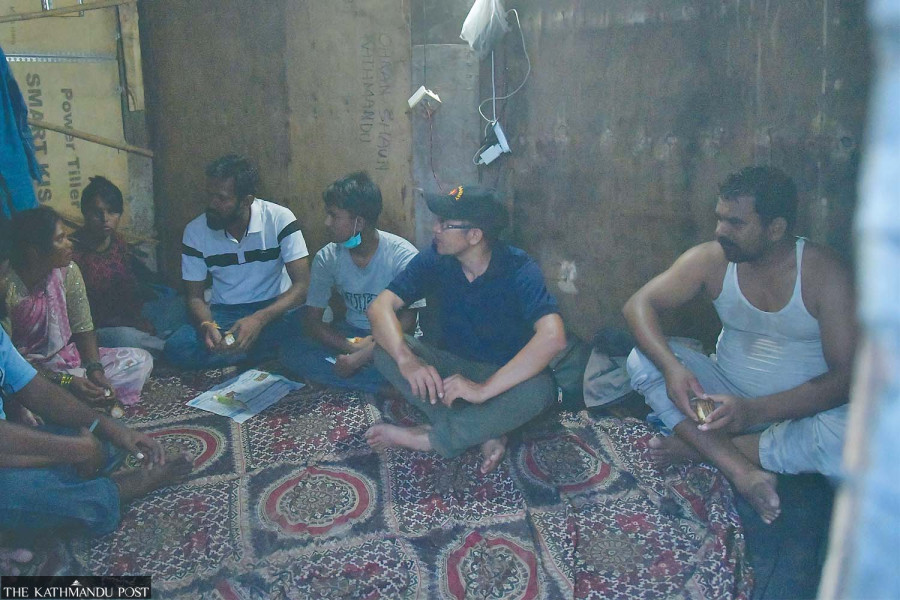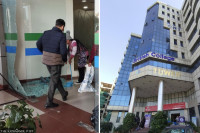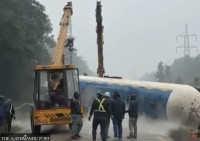National
‘All we got was silence’: Chure activists share their ordeal
After staging protests for over three months in the Capital with no government response, Chure activists now prepare for the second phase of their agitation.
Aarati Ray
Until Wednesday, about a dozen-and-a-half activists huddled together in a dimly lit two-room shelter, sleeping on tarps with only thin bed sheets for cover. They relied on muddy water from a hand pump for hydration and used a roofless crumbling toilet.
This group lived in a makeshift shelter at the Thapathali squatter settlement in Kathmandu, paying a monthly rent of Rs10,500.
Among them was Nandakishor Ram Bibsh, a Chure conservation activist, who endured the harsh conditions for two months despite having a home and family back in Rautahat.
“I’m not a squatter, yet the government forced us into this position,” Bibsh says. “Our suffering could have meant something if the government had listened, but all we got was silence.”
The deafening silence forced them to reconsider their approach. On August 14, Bibsh and his fellow activists, who began their 25-day march from Saptari to Kathmandu on April 28, decided to leave the Thapathali camp.
After over three months of sit-in amid harsh conditions, they returned to Janakpur, frustrated at the government’s continued inaction.
Sunil Yadav, the central coordinator of the Chure conservation campaign, emphasises that their return is a start of the second phase of their protest. In their next move, the activists plan to raise public awareness by staging protests in every district of Madhesh before returning to the Capital with a bigger force by the end of August.
On August 22, they even plan to hold large-scale demonstrations in front of the Madhesh chief minister’s residence.
Yadav and his team aim to draw the government’s attention to the Chure range, a strip of geography running along Nepal’s east to west as the foothills above the plains that is devastated by over 30 years of deforestation, illegal mining and encroachment.
This environmental damage has led to severe consequences like water shortages, landslides, soil erosion, and crop failures, impacting thousands who live there and down south.
Equally appalling for the protesters is the government’s indifference. “We came to the Capital with empty buckets to symbolise the urgent need for water conservation. Those buckets got filled with our frustrations at the government’s indifference,” Yadav said.
The poor living conditions during the march and protests have taken a toll on many activists’ health. Many had to travel back and forth between Madhesh Province and Kathmandu to manage personal affairs, health, and their responsibilities to the campaign.
“It’s a shame that I had to leave my family and endure such hardships just to be heard,” Bibsh says. “We were driven to sleep on the streets and had to live in the squatter settlement. I don’t know how much more suffering the government needs to see.”
On July 31, heavy rain flooded their residence in the squatter settlement in Thapathali, causing great distress among the activists. “Every time it rained, I was terrified that the roof might collapse,” says Sangita Sada, a 37-year-old from Lahan in Siraha district.
During the protest, Sada frequently battled fever from the cold seeping through the floor and the harsh conditions. “I wasn’t the only one,” she says. “Almost all of us suffered from fever and cold multiple times.”
Despite her illness, Sada forced herself to rise early each morning to fetch muddy water from the hand pump and cook for the group. She would then participate in the sit-in protests from 10 am to 6 pm before returning to the settlement to prepare dinner for the night.
“We couldn’t afford jar water. We had no proper facilities for cooking, bathing, or toilets,” Sada adds.
Elderly participants like 65-year-old Shanti Devi have endured even greater hardships. Devi, from Dhanusha, now suffers from chronic back pain as a result of the 25-day march. “I will have to use a walking cane forever”, said Devi.
The activists have a 12-point list of demands. These include enacting a Chure Conservation Act, designating the Tarai as a dry zone, banning sand and stone mining in riverbeds, addressing pollution in the Sirsiya river, and stopping environmentally harmful construction projects. They also seek an investigation into forest workers involved with smugglers in illegal extraction activities.
In 2014, the Nepal government declared the Chure an ‘Environmental Protection Area’ and established the President Chure-Tarai Madhesh Conservation Development Board (PCTMCDB) to oversee its conservation.
However, research from November 2019 reveals that the board has struggled with its ad hoc approach and lacks a fully empowered office, integrated policies, and an independent conservation fund.
Amidst the protest, Sada’s savings of Rs11,000 were spent on medicine and basic needs, while her husband struggled to support their family through his labour wages.
Now, back home, Sada faces criticism from villagers for mingling with men and being away from her family. “As a woman participating in these protests, I face constant judgement, but I won’t give up,” she says. “Water is scarce, and I fear I won’t be able to provide my grandchildren even a glass of water.”
In Madhesh, locals in districts like Bara and Rautahat now rely on water tankers due to declining water levels. Farmers are using water pumps and seeking alternative income sources, leading to the closure of many rice mills, according to Yadav.
Upon arriving in Kathmandu, the activists first stayed at a small hotel but moved to the office of the Madhesi Nijamati Karmachari Manch due to financial constraints after one night. After 20 days, they were asked to leave the office. They then found accommodation in a squatter settlement with no other option.
Struggling with rent and basic needs, they sought support from people in Madhesh and spent their meagre earnings. “Managing funds was tough, especially as many of us fell ill,” says Bibsh.

Kiran Paudel, chairperson of the PCTMCDB, shares that he has sent the memorandum of campaigners’ demands to the Ministry of Forests and Environment.
“We are planning on a Chure Conservation Act within the next three months and actions for river conservation,” Paudel says. “We are just a board—demands such as declaring the Tarai a dry zone, banning riverbed mining, and halting harmful construction projects are politically complex, requiring provincial and federal attention.”
On August 5, the activists marked their 100th day of protest with a march from Maitighar to the prime minister’s residence in Baluwatar, aiming to draw the government’s attention.
During this time, “we have suffered losses that have been too hard to swallow,” says Yadav.
Elderly activist Nanda Mukhiya from Janakpur died on July 22, due to health complications worsened by the harsh living conditions during the march and protest. Despite his deteriorating health, Mukhiya had insisted on continuing the protest until he was forced to return home, where he died shortly thereafter.
Bibsh argues that if the Khas Arya Pahadi community were affected by Chure destruction or staged a similar march, it would be a major national topic. “Madhesh issues are often overlooked in Nepal. We are rightful citizens, and the Chure issue affects the entire country,” he said.
As they prepare for the second phase of their protest, the activists continue to fight for Chure’s future. The pressing question remains: how much longer will their voices be ignored, and what more must they endure to be heard?
Sada worries that the next time they return to Kathmandu, they may not even secure space in a squatter settlement and might end up sleeping on the streets due to lack of funds. “How long should this continue?” she asks.
“At Maitighar Mandala, I saw many give up, exhausted by the government apathy. Can it truly be called a government if it wears out its own people seeking justice? If we fail, whose failure is it—ours or the government’s?”




 10.12°C Kathmandu
10.12°C Kathmandu













%20(1).jpg&w=300&height=200)

